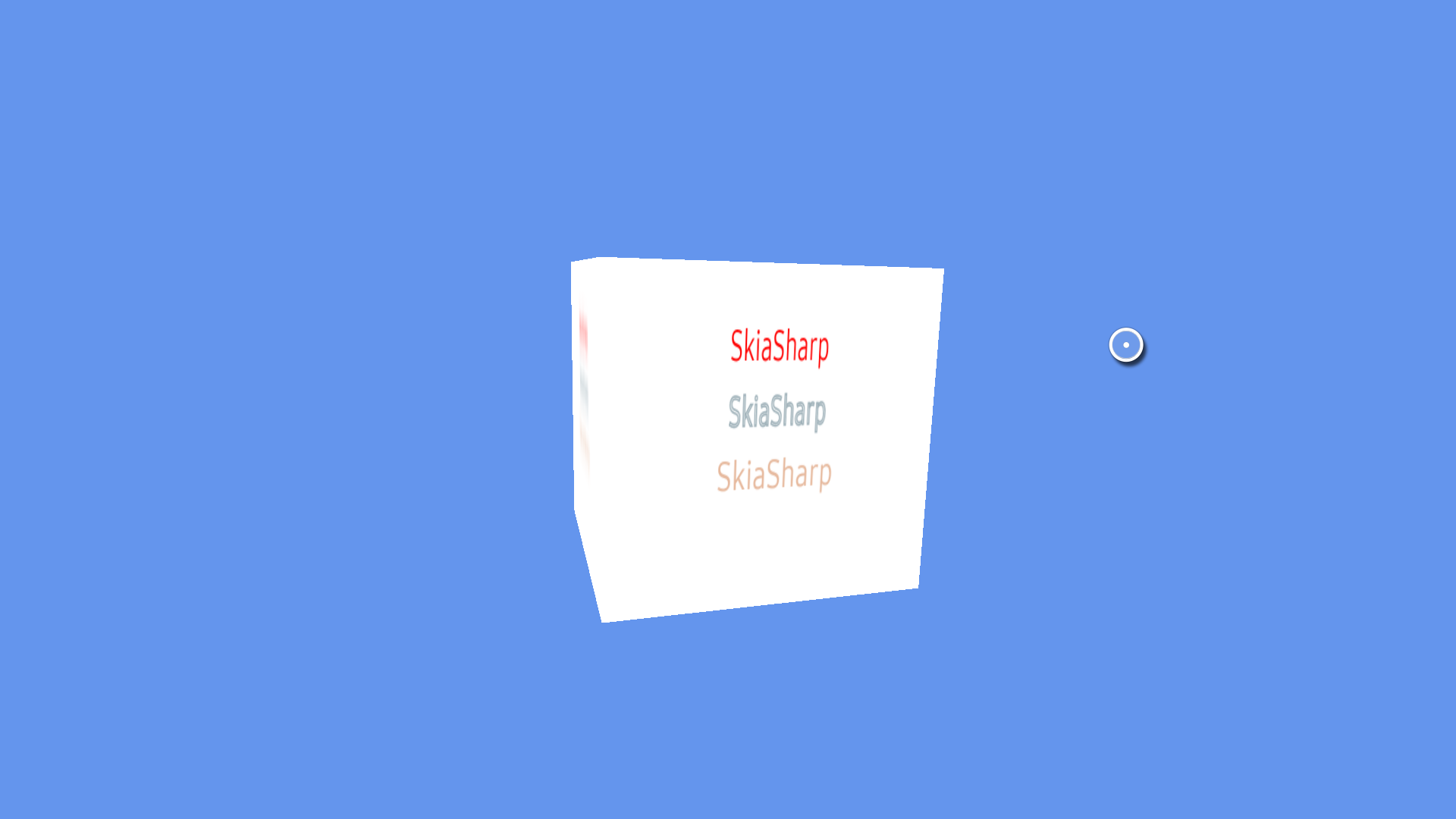Create Applications with SkiaSharp
PUBLISHED
SkiaSharp is a cross-platform 2D graphics API for .NET platforms based on the Skia Graphics Library of Google. It provides a comprehensive 2D API that is used across mobiles, servers, and desktop models to render images.
In OpenTK app, you can use SkiaSharp to draw geometries, texts, or images. For more information about the SkiaSharp APIs, see SkiaSharp API document.
To draw a text using SkiaSharp in the OpenTK application, use the following guidelines:
- Allocate a memory block as a canvas for SkiaSharp.
- Create a SKCanvas on this memory block, and render text or image that you want on this SKCanvas.
- Create a 2D texture from this memory block.
- Draw a 2D texture with graphics APIs of OpenTK.
Allocate Memory Block
Allocate a specific size of the memory block. The size of memory block must be same as the size of the canvas you want.
private IntPtr pBitMap; // memory handle
private int rowByte; // bytes of one row
private int bitmapHeight, bitmapWidth; // height and width of the canvas
private void CreateBitmap()
{
bitmapHeight = (int)(skiaPercent * mainWindow.Height);
bitmapWidth = (int)(skiaPercent * mainWindow.Width);
pBitMap = Marshal.AllocHGlobal(bitmapWidth * bitmapHeight * 4); // allocate a memory block
rowByte = bitmapWidth * 4;
}
private void FreeBitmap()
{
if (pBitMap != IntPtr.Zero)
{
Marshal.FreeHGlobal(pBitMap); // free the allocated memory block
pBitMap = IntPtr.Zero;
}
}
Create SKCanvas on Memory Block
Create SKSurface on the memory block and then you can get the SKCanvas from the SKSurface:
private SKSurface surface;
private SKCanvas canvas;
private void CreateSKCanvas()
{
GL.PixelStore(All.UnpackAlignment, 4);
// create the surface
var info = new SKImageInfo(bitmapWidth, bitmapHeight, SKImageInfo.PlatformColorType, SKAlphaType.Premul);
surface = SKSurface.Create(info, pBitMap, rowByte);
if (surface != null)
{
canvas = surface.Canvas;
}
}
Draw Text on SKCanvas
Set a color and draw text on the canvas:
private void DrawTextBySkiaSharp(SKCanvas canvas, int canvasWidth, int canvasHeight)
{
canvas.DrawColor(SKColors.White); // Change the canvas as white
using (var paint = new SKPaint())
{
paint.TextSize = 64.0f;
paint.IsAntialias = true;
paint.Color = SKColors.Red;
paint.IsStroke = false;
paint.TextAlign = SKTextAlign.Center;
canvas.DrawText("SkiaSharp", width / 2f, 144.0f, paint); // Draw text "SkiaSharp" on the canvas
}
}
private void DrawTextOnSkCanvas()
{
if (canvas != null)
{
DrawTextBySkiaSharp(canvas, bitmapWidth, bitmapHeight);
canvas.Flush();
}
}
Create 2D Texture from Memory Block
Call GL.TexImage2D of OpenTK.Graphics.ES20 to generate 2D texture from the memory block:
private void Create2DTextureFromMemory()
{
GL.TexImage2D(
All.Texture2D,
0,
All.BgraExt,
bitmapWidth,
bitmapHeight,
0,
All.BgraExt,
All.UnsignedByte,
pBitMap
);
GL.TexParameter(All.Texture2D, All.TextureMinFilter, (float)All.LinearMipmapLinear);
GL.TexParameter(All.Texture2D, All.TextureMagFilter, (float)All.Linear);
GL.GenerateMipmap(All.Texture2D);
}
Draw 2D Texture
Draw a 2D texture with graphics APIs of OpenTK:
private IGameWindow mainWindow; // window
private float[] vertices; // vertex array
private float[] textCoord; // texture coordinate array
private int mProgramHandle; // program handle
protected override void OnCreate()
{
mainWindow = Window;
mainWindow.RenderFrame += OnRenderFrame;
}
private void OnRenderFrame(Object sender, FrameEventArgs e)
{
GL.Viewport(0, 0, mainWindow.Width, mainWindow.Height);
GL.ClearColor(Color4.CornflowerBlue);
GL.Enable(All.DepthTest);
GL.Clear(ClearBufferMask.ColorBufferBit | ClearBufferMask.DepthBufferBit);
GL.UseProgram(mProgramHandle);
positionLoc = GL.GetAttribLocation(mProgramHandle, "a_position");
texCoordLoc = GL.GetAttribLocation(mProgramHandle, "a_texCoord");
textureLoc = GL.GetUniformLocation(mProgramHandle, "s_texture");
GL.Uniform1(textureLoc, 0);
unsafe
{
fixed (float* pvertices = vertices)
{
// Prepare the triangle coordinate data
GL.VertexAttribPointer(positionLoc, 3, VertexAttribPointerType.Float, false, 6 * sizeof(float), new IntPtr(pvertices));
GL.EnableVertexAttribArray(positionLoc);
}
fixed (float* texCoord = textCoord)
{
GL.VertexAttribPointer(texCoordLoc, 2, VertexAttribPointerType.Float, false, 2 * sizeof(float), new IntPtr(texCoord));
GL.EnableVertexAttribArray(texCoordLoc);
}
}
mvpLoc = GL.GetUniformLocation(mProgramHandle, "u_mvpMatrix");
// Apply the projection and view transformation
GL.UniformMatrix4(mvpLoc, false, ref mvpMatrix);
GL.DrawArrays(All.Triangles, 0, 36);
GL.Finish();
// Disable vertex array
GL.DisableVertexAttribArray(positionLoc);
GL.DisableVertexAttribArray(inColorLoc);
mainWindow.SwapBuffers();
}
Sample Application
There is a OpenTK sample application that uses SkiaSharp to draw text on a rotating cube.
Figure: Sample application running on TV emulator

For more information, see Tizen-CSharp-Samples repository on GitHub.
Was this document helpful?
We value your feedback. Please let us know what you think.
